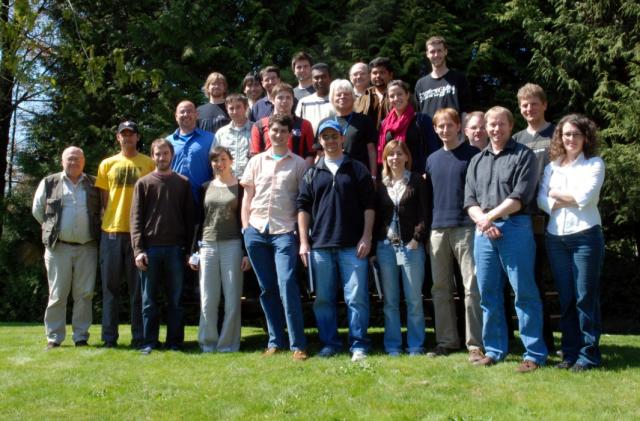"We are at the end of the beginning. Now begins the middle," said Professor John Wood as I sat down to talk with him about the future of nuclear structure physics and his work at TRIUMF. "We can now see the terrain ahead much more clearly, having removed some serious misconceptions," he added. For the past 50 years, he said, a major challenge has been to figure out which ideas in nuclear physics are the best with which to work and which ones looked pretty good from a distance but didn't stand up to close scrutiny. Such is the progress of science! (For instance, in atomic physics it took from 1880 to 1930 to 'get it straight'.)
Hailing originally from Cornwall, England, and at Georgia Tech in Atlanta since 1972, John has been coming to TRIUMF for more than a decade. In response to Gordon Ball's inquiry in July 2008, "Now that you are retired, can we see more of you?" John said that TRIUMF was at the top of his list. He agreed to come and give advanced lectures on nuclear structure. He noted that this undertaking is very timely because, with David Rowe at the University of Toronto, he is finishing Volume 1 of a pair of monographs under the combined title "Fundamentals of Nuclear Models: "Vol. 1 is called "Foundational Models" and Vol. 2 is called "Unified Models".
Calling the presentations "chalk and talk" so that the participants could interrupt with questions and comments while he worked at the blackboard, John explained that he sought to bridge the gap between basic coursework in graduate school and the type of mastery of the science that is needed to pursue research. These morning lectures have been attended regularly by more than two dozen students and even some of the senior TRIUMF staff. In fact, as we spoke just before John headed back to the US, a graduate student poked his head into my office to eagerly thank John for the lectures, promising to read all the notes carefully.
John's own research with TRIUMF began with the 8 Pi Spectrometer, a device that returned to Canada from Lawrence Berkeley Lab in the US (it was born in Chalk River!). Originally the 8 Pi was built to study rapidly spinning nuclei. At Berkeley, John, working with his then graduate student David Kulp, demonstrated that it could achieve unprecedented precision in the study of nuclear structure observed via radioactive decay. For John "retirement" is a relative word that he describes as shedding administrative and bureaucratic duties so that he can pursue his love of physics. He emphasized the high value that he places on the collegiality at TRIUMF and the excellence of the environment for "thinking".
Returning to the future of nuclear physics, John added that he expected to see a much closer integration of ideas from nuclear physics with those from particle physics and condensed matter physics and that this has been one of his long-standing side interests.
John plans to return in the summer to give more lectures. Mark your calendars!
"Class" of regulars participating in John Wood's lectures.
--By T.I. Meyer

